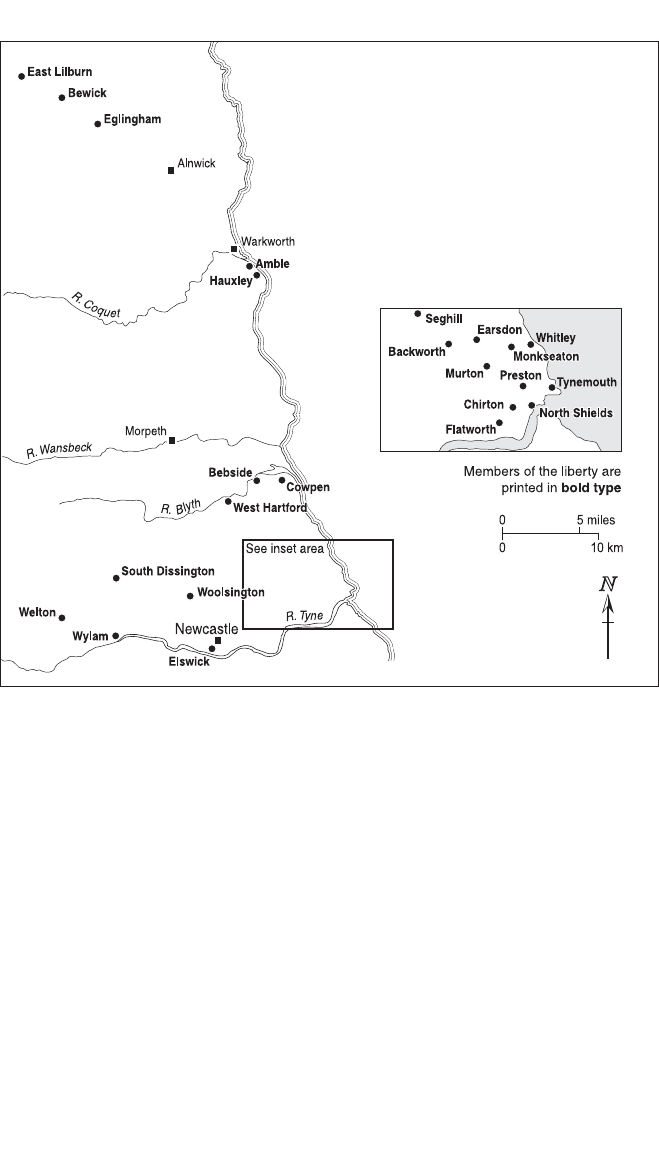Holford Matthew, Stringer Keith. Border Liberties and Loyalties in North-East England, 1200-1400 (ENG)
Подождите немного. Документ загружается.


BORDER LIBERTIES AND LOYALTIES
196
In the rst place, the liberty did not have the powerful cultural coherence of
Durham ‘between Tyne and Tees’. e archbishops of York seem to have
made no e ort to develop a historical mythology around the liberty, and
there was less overlap than in Durham between the claims of the major reli-
gious house and the privileges of the wider liberty. Hexham Priory was not
an articulate defender of Hexhamshire’s rights, and it was di cult for loyal-
ties towards priory and liberty to interact in the way that could happen in
Durham. Nor was the priory the focus of a saint’s cult powerfully associated
with the liberty. Indeed, there are even grounds for doubting the strength
of loyalties towards the priory within Hexhamshire. In nearby areas of
Northumberland there is clear evidence of the priory’s popularity. We might
note in particular the grants made by successive Umfravilles of lands in
Birtley, Chollerton and Cowden, and the burial of Earl Gilbert II Umfraville
(d. 1307) in the priory. In 1285 omas Dilston, who was also to be buried
at the priory, granted to the canons the manor of North Milbourne, said to
be worth £20 p.a.; and the priory owed to the generosity of others lands in
Allerwash, Chipchase, Gunnerton, Settlingstones, Slaley and elsewhere.
132
Within the liberty, though, enthusiasm for the priory is harder to detect. By
about 1300 it owed most of its rights and possessions there to archiepisco-
pal su erance and grant, and relatively little to the piety of local gentry – a
moiety of Bing eld, granted by one Germund in the twel h century, and six
marks of rent in the same vill, granted by Robert Skipton, one of the liberty’s
thirteenth- century baili s.
133
Nor does local generosity seem to have been
much greater in the fourteenth century, when the priory acquired two mes-
suages in Hexham in 1343, and thirty shops in Hexham, and forty acres in
Anick, in about 1350.
134
Indeed, the priory was not the only recipient of reli-
gious patronage in the liberty: another lord of Bing eld had granted lands in
the vill to the hospital of the Virgin Mary in Newcastle.
135
Identi cation with the liberty was also complicated, we may suspect,
by the tenurial and social ties that linked Hexhamshire to other parts of
Northumberland. So it was that, in the thirteenth century, Peter Vaux and
Adam I Bertram both held signi cant estates to the east of the liberty as well
as inside it; that lands in Portgate and Whittington descended together; and
that Simon and Adam Bing eld came to have interests in Redesdale.
136
In
132
CPR 1281–92, p. 167; Hexham Priory, ii, p. 113. For the priory’s other possessions, see
especially ibid., pp. 107–17; for the burials, Northumbrian Monuments, ed. C. H. H. Blair
(NRC, 1924), pp. 97–8.
133
Hexham Priory, ii, pp. 109, 134; cf. Reg. Romeyn, ii, no. 1273.
134
Reg. Zouche, ff. 291Ar, 296Av.
135
W. H. Knowles and C. J. Bates, ‘The hospital of St. Mary the Virgin, Newcastle’, AA, new
ser., 15 (1892), p. 203.
136
Above, pp. 181, 184; below, Chapter 8, pp. 375–6.
M2107 - HOLFORD TEXT.indd 196M2107 - HOLFORD TEXT.indd 196 4/3/10 16:12:564/3/10 16:12:56

HEXHAMSHIRE AND TYNEMOUTHSHIRE
197
the mid- fourteenth century, Joan daughter of John Coastley was married
to Ralph son of omas Surtees, and it seems that John’s wife Cecily was
a Swinburne.
137
Such ties were only to be expected, given the lack of any
major boundaries separating Hexhamshire from its neighbours, and given
the liberty’s small community of greater freeholders, which meant that the
most attractive marriages and property speculations almost inevitably lay
outside the liberty.
It was still possible for local people with signi cant interests elsewhere to
have a distinctive relationship with the liberty, particularly if o ce- holding
in Hexhamshire gave them opportunities they did not nd outside it. is
was perhaps the case in the later thirteenth century, when John Errington
acted as a justice of assize and gaol delivery, and Robert Errington was a
justice and commissioner of array.
138
In the fourteenth century, certainly,
most of the liberty’s coroners and jurors were Hexhamshire men. For
example, Matthew Catton and Richard Wacy both served as coroners in
the early 1300s. Wacy, who held lands in Greenridge, was probably the
son of the William Wacy who, like Catton, witnessed local deeds and was
a juror in 1296. Richard Wacy himself, or perhaps a son of the same name,
was a liberty juror in the 1320s.
139
And none of these men has been traced
as a juror in county government. Such examples remind us not to exagger-
ate the connections between Hexhamshire and neighbouring society, and
suggest how the liberty’s government may have helped to de ne and articu-
late something of a distinctive local community. Yet counter- examples are
easily found. Catton’s and Wacy’s contemporary Anthony Errington acted
with some frequency as a juror in Northumberland; while, in the later four-
teenth century, the Hexhamshire juror Adam Bolton also appeared on an
inquest regarding Redesdale.
140
Ultimately, moreover, the distribution of o ce and patronage in
Hexhamshire o ered relatively little for local men. In general local free-
holders – many of whom, a er all, were not wealthy or substantial gures –
could expect to serve only as jurors or, at best, as coroners. Hugh Errington,
a coroner around 1330, is a typical example.
141
Some men were undoubtedly
content with such roles. But the more ambitious were forced to seek service
and advancement outside the liberty, and may have come to resent the lack
137
ADM 75/150, Coastley, nos. 5, 7; NDD, p. 209.
138
Reg. Wickwane, no. 549; Reg. Romeyn, ii, nos. 1225, 1243, 1334; Reg. Corbridge, ii, no. 964.
139
J. C. Hodgson, ‘The Brumell collection of charters, etc.’, AA, new ser., 24 (1903), p. 117;
NCS, ZSW/1/6; 169/2; NCH, iii, p. 34; Reg. Melton, ff. 488r, 516r; C 145/140/7.
140
HN, II, ii, pp. 251, 473; NCH, iii, p. 34; iv, p. 292; ADM 75/150, Coastley, no. 7; C
136/48/5.
141
Reg. Melton, f. 541r.
M2107 - HOLFORD TEXT.indd 197M2107 - HOLFORD TEXT.indd 197 4/3/10 16:12:564/3/10 16:12:56

BORDER LIBERTIES AND LOYALTIES
198
of openings available to them locally. Men looking outside the liberty might
also be drawn to the ‘frontier culture’ that was developing especially in
neighbouring Tynedale, with deleterious e ects on society in Hexhamshire
itself.
142
And, as we will nd, this was especially true from the 1350s, when
government in the liberty became even less open to local men.
We have seen that John II Vaux was the only layman with roots in the
liberty to hold major o ce in the fourteenth century; we have also seen,
however, that he moved as much outside the liberty as within it. His
descendants held no major o ce in Hexhamshire; and they were likewise
active outside the liberty, albeit at a less impressive level. is was partly
because they inherited his landed interests: John II’s grandson Adam, who
received the bulk of the family estates, held property in Aydon and Little
Whittington which could support a rent charge of £30 p.a.
143
And John
had also established connections with several county families. His daugh-
ters were married into the Cli ords of Ellingham and the Swinburnes of
Capheaton; his son John III married a daughter of Adam Baret of Walker;
and another son, Gilbert, married Joan Middleton of Belsay, thus acquiring
ornbrough.
144
is Gilbert retained some interests in Hexhamshire;
145
but he was equally active outside it, ghting in Scotland, acting as a frequent
witness in and around ornbrough, and serving as a county juror. In 1375
he was also one of the pledges for a ne of 1,000 marks owed by ‘the men
of Northumberland’.
146
Richard Vaux of Fallow eld, similarly, was a juror
in Hexhamshire; but he, too, earned a name outside the liberty, albeit a less
reputable one: he was involved in John Coupland’s murder in 1363, and
had joined the retinue of the Tynedale warlord, William IV Swinburne,
by 1385.
147
It is true that, despite such interests outside Hexhamshire, the
liberty does seem to have retained some signi cance for the Vauxs. e
heads of the family continued to identify themselves as ‘of Beaufront’, and
some of their conveyances show a notable awareness of Hexhamshire’s
jurisdictional independence.
148
John V Vaux married a daughter of Roger
142
On Tynedale, see below, Chapter 7, passim.
143
NCH, x, p. 381, n. 4; cf. also JUST 1/1453, m. 8d.
144
NCH, ii, p. 229; NYCRO, ZAZ 78 (MIC 1324/547).
145
For his activities as witness and juror, see for example NCH, iv, p. 202; Reg. Zouche, f.
296v; Greenwell Deeds, no. 207.
146
E 101/19/36, m. 5; NCH, x, pp. 92, n. 6, 249, n. 2, 253, n. 1, 438; HN, II, ii, pp. 6, 340; CIPM,
xi, no. 618; xiii, no. 61; JUST 1/661, m. 2; E 159/152, recorda, Michaelmas, m. 14d.
147
ADM 75/150, Coastley, no. 7; below, Chapter 7, p. 333. Alan, Richard and William Vaux
were received at Acomb and Anick after Coupland’s murder: JUST 1/661, m. 1d. They
were probably all related to the chief felon, John Clifford of Ellingham, whose mother
Elizabeth was apparently the daughter of a John Vaux: NCH, ii, p. 229.
148
Thus the arrangements for a marriage settlement of 1357 distinguished between lands
in the county of Northumberland and in the liberties of Durham, Hexhamshire and
M2107 - HOLFORD TEXT.indd 198M2107 - HOLFORD TEXT.indd 198 4/3/10 16:12:564/3/10 16:12:56

HEXHAMSHIRE AND TYNEMOUTHSHIRE
199
Widdrington, and in 1385 he was retained for service in Scotland; but, as has
been shown, he continued to style himself ‘of the county of Hexham’.
149
For other men, similarly, ambitions outside the liberty did not preclude
performing minor administrative roles within it, as in the case, for example,
of Adam Serjeant of Hexham, a liberty juror who served in Scotland in
1344.
150
Elsewhere, however, the lack of real openings in the liberty may
well have caused resentment. William Redshaw was clearly an ambitious
and assertive man, keen to carve out a place for himself in Hexhamshire; but
his o cial responsibilities were limited to jury service.
151
When in 1347 he
murdered a former baili of the liberty, William Hawsker, he was perhaps
giving vent to his frustration at such limitations.
152
Redshaw’s descendants
also found few opportunities in the liberty. William had served in Scotland
in the 1330s; his descendants were in the retinue of William Hilton, under
Henry Percy, in 1385. William II Redshaw was a collector for the 1381 poll
tax in Northumberland.
153
Not all the family’s activities outside the liberty
were so respectable, however: John son of William Redshaw, alias John
Redshaw of Cocklaw, was indicted for a murder at Chollerton in 1364,
although he was able to adduce a royal pardon.
154
If there were frustrations and resentments in local society, they are likely
to have been exacerbated by signi cant changes in the liberty’s governance
a er about 1355. It was in this year that Richard Ask was appointed baili ,
for the substantial term of six years; in 1357, furthermore, he was con rmed
in o ce for life; and he seems to have held the position until his death
around 1369. Like several of his predecessors, Ask was a Yorkshireman,
an outsider to the liberty; but he held o ce for an unprecedented length
of time. In 1364 he was also allowed to appoint a lieutenant, and was thus
given the opportunity either to become a local tyrant, or to neglect the
government of the liberty entirely.
155
And a similar situation emerged in
Tynedale: DCM, Misc. Ch. 6947; Greenwell Deeds, no. 208, NDD, p. 238; NCH, ix, p. 320,
n. 5. See also NDD, p. 239; Greenwell Deeds, no. 230.
149
BL, Cotton Roll XIII.8; above, p. 195.
150
CDS, v, no. 3780; Reg. Melton, ff. 509r, 516; Reg. Zouche, f. 296v; ‘North country deeds’,
ed. W. Brown, Miscellanea II (SS, 1916), p. 115.
151
Reg. Zouche, f. 296v; C 145/140/7. He was, however, able to have his son John appointed
keeper for life of the hospital of St Giles, Hexham, in 1359: Reg. Thoresby, f. 302v.
152
Reg. Zouche, f. 295r; cf. CPR 1348–50, p. 20. Redshaw was also pardoned for a homicide
in 1351: Reg. Zouche, f. 298r.
153
E 101/19/36, m. 5; 101/20/17, m. 9d; 101/20/18; 101/40/5; BL, Cotton Roll XIII.8; CFR,
ix, p. 227.
154
JUST 1/661, m. 4d; CPR 1361–4, pp. 107, 522.
155
Reg. Thoresby, ff. 300r, 301r–v; CPR 1358–61, p. 557; NCH, iii, p. 65 (where, however,
Ask’s appointment for life is misdated). Death probably accounts for his disappearance
from the record after about 1369.
M2107 - HOLFORD TEXT.indd 199M2107 - HOLFORD TEXT.indd 199 4/3/10 16:12:564/3/10 16:12:56

BORDER LIBERTIES AND LOYALTIES
200
the later fourteenth century. omas Blenkinsop, appointed baili in 1377,
was replaced in 1382 by John Clavering. Like Ask, Clavering was appointed
for life; he was also allowed to appoint a deputy; and he seems to have held
his o ce until at least 1398.
156
Signi cantly, though, he complained in 1398
that his position had been partly usurped by William IV Swinburne.
157
is
may suggest that the liberty had not been central to Clavering’s concerns;
and, in fact, it seems very likely that it was the increasing tendency for
stewards to be non- resident that led to the appointment of a chancellor
of the liberty by the 1370s or thereabouts.
158
We must also remember that
Clavering owed his appointment to a family connection with Archbishop
Neville. Here indeed the liberty was apparently used as a ‘pawn on the
board of political patronage’; and it would not be surprising if, as a result,
‘the bond between lord and local society’ was sorely tested.
159
In fact, the e ect of these appointments on local society is unclear,
because the archbishops’ registers provide little information about the
liberty a er 1355. In this year, the date of Ask’s appointment, the seal for
Hexhamshire was sent from York to the liberty’s baili : therea er, it would
seem, most of the liberty’s writs were issued locally, and only items of
particular importance were dealt with and registered at York.
160
e arch-
bishops did not totally cede oversight of Hexhamshire: in 1378, for example,
Alexander Neville appointed seven justices to inquire into felonies commit-
ted in the liberty by o cials and others.
161
But such periodic assertions of
authority cannot have concealed the extent to which day- to- day power
now lay in the hands of the steward/baili . And while it is not entirely clear
what this meant in practice, there are some signs that the liberty’s govern-
ment became less regular and e cient; and indeed that it buckled under
the strains of the later fourteenth century, when cross- Border raiding was
combined with wider political instability.
156
Reg. Neville, f. 104v; NCS, ZBL/23/1/2, 3; CPR 1381–5, p. 410; CIMisc., vi, no. 337. John
Mitford, lawyer and administrator, was briefly appointed steward when the liberty was
in crown hands in 1388: CPR 1385–9, p. 413; HC, iii, pp. 744–6.
157
NCS, ZSW/1/96. Swinburne’s significant presence in the liberty in 1398 is confirmed by
NCS, ZSW/1/98, an indenture witnessing that he and the prior of Hexham had purchased
all debts owed to the archbishop of York in Hexhamshire.
158
The chancellor of the liberty first seems to occur in 1376, although in terms that may
suggest earlier existence (Reg. Neville, f. 101v, referring to the powers pertaining to the
office ‘by right and custom’). In 1393 an inquisition post mortem in the liberty was held
before the chancellor (ADM 75/150, Coastley, no. 7). This duty had belonged to the
steward/bailiff in the earlier fourteenth century; and in 1355 it was the steward/bailiff to
whom the seal of the liberty was delivered (Reg. Thoresby, f. 300r).
159
R. R. Davies, The Revolt of Owain Glyn Dŵr (Oxford, 1995), p. 44.
160
Reg. Thoresby, f. 300r.
161
Reg. Neville, f. 91v.
M2107 - HOLFORD TEXT.indd 200M2107 - HOLFORD TEXT.indd 200 4/3/10 16:12:564/3/10 16:12:56

HEXHAMSHIRE AND TYNEMOUTHSHIRE
201
From the late 1370s the North- East su ered again from renewed Scottish
raids.
162
eir economic impact in Hexhamshire cannot be quanti ed, but
may well have been considerable: while Hexham Priory’s rental of 1379 does
not refer to damage from raiding, in 1405 the priory was granted rents to the
value of £100 by Henry IV as compensation for such damage.
163
And the inse-
curity that resulted from raiding may also have contributed to social disloca-
tion. From the 1380s onwards, at any rate, law and order in Hexhamshire do
seem to have deteriorated noticeably. Men from the liberty appear more o en
in the records of Northumberland gaol deliveries, indicted for o ences com-
mitted inside and outside Hexhamshire.
164
In about 1382 William Carnaby,
John Errington and John Redshaw led a gang of local men on a raiding
mission to Halton; and in 1385 another such party raided Whittonstall.
165
From the late 1380s the liberty also su ered a crisis of leadership as suc-
cessive archbishops fell foul of Richard II, his aristocratic opponents, and
Henry IV. Earlier fourteenth- century archbishops, by and large, had been
reliable royal servants: William Green eld was Edward I’s chancellor (1302–
5); William Melton was Edward II’s keeper of the wardrobe, treasurer, and
keeper of the privy seal; William Zouche was Edward III’s treasurer (1337–
8); and John oresby was keeper of the privy seal (1345–7) and chancellor
(1349–56). Conversely, Alexander Neville (1374–88), omas Arundel
(1388–96) and Richard Scrope (1398–1405) all played more dramatic
parts in high politics, with a signi cant impact on the liberty’s governance.
Neville, condemned by the Appellants in 1388, lost his temporalities, and
Hexhamshire came brie y into the crown’s hand – even if the scanty nature
of Neville’s register and the loss of Arundel’s make it di cult to assess the
local impact of Neville’s forfeiture.
166
Arundel had been replaced by Robert
Waldby before he, in turn, was condemned in Parliament in 1397. Waldby’s
brief episcopate (1397–8), moreover, can hardly have eased the dislocation
apparent at this time in the liberty’s administration, most notably when
William IV Swinburne ‘usurped’ the o ce of steward.
167
162
A. J. Macdonald, Border Bloodshed (East Linton, 2000), Chapter 2, and passim.
163
CPR 1405–8, p. 51.
164
For example, JUST 3/169, mm. 32d (where ‘Alwenton’ is probably Allendale Town rather
than Alwinton), 33; 3/176, m. 21–21d; 3/191, m. 45–45d. For reasons that are unclear, the
justices who delivered the royal gaol at Newcastle heard pleas relating to men from liber-
ties – even from the liberty of Durham (JUST 3/141A, m. 45d) – and concerning offences
committed therein. Their cognisance of such pleas is known to have been challenged only
in 1410 (below, p. 202).
165
CPR 1381–5, pp. 144–5, 507–8.
166
For the context, see N. Saul, Richard II (New Haven, 1997), pp. 184–5, 193. Only the
register of Arundel’s vicar- general is extant: Borthwick Institute, Reg. 14.
167
Saul, Richard II, pp. 377–8; cf. A Calendar of the Register of Robert Waldby, Archbishop
of York, 1397, ed. D. M. Smith (York, 1974), pp. 2, 5.
M2107 - HOLFORD TEXT.indd 201M2107 - HOLFORD TEXT.indd 201 4/3/10 16:12:574/3/10 16:12:57

BORDER LIBERTIES AND LOYALTIES
202
Scottish raids, which had abated for much of the 1390s, increased again
towards the end of the decade; and the opening years of the eenth
century seem to have been di cult ones in the liberty. ere are few
signs that Archbishop Scrope saw to the good order of Hexhamshire, and
his rebellion against Henry IV brought the liberty into the king’s hands
between June 1405 and December 1407. In 1408 the prior of Hexham
was accused of dealing with the Scots, perhaps in connection with the
Percy rebellion of that year; and in 1410 a ‘common leader of Scots in
England’ was released by royal justices because his o ences had taken
place in Hexhamshire. e felon’s defence – that the liberty was ‘outside
the county of Northumberland’ – is a rare example of a direct appeal to
its status. But the incident not only suggests that the liberty’s privileges
had become attractive to criminals; it implies that Hexhamshire’s own
judicial systems had ceased to be e ective. In such circumstances it is not
surprising that Parliament should have heard complaints from the people
of Northumberland about the inhabitants of Hexhamshire, alongside those
of Tynedale and Redesdale, in 1414 and 1421.
168
ese petitions, which
essentially demanded that liberty o cers be forced to hold assizes and gaol
deliveries regularly, may even have represented the interests of sections
of liberty society. It is certainly suggestive that the receiver’s account for
1421–2 recorded pro ts of £4.2s.3d. from ‘various courts’ held at Hexham –
probably the comitatus and ‘court baron’ – but noted that ‘no other sessions
of justices’ were held in that year.
169
Hexhamshire’s position in the Tyne valley, on a favoured route for
Scottish incursions, made it vulnerable when Anglo- Scottish relations dete-
riorated, even if it never su ered to the same extent as did Redesdale and
Tynedale. But like those areas, where royal o cials were not accustomed
to acting, Hexhamshire required strong and active lordship to maintain
local stability: and such lordship, it would seem, is precisely what the arch-
bishops of York ceased to supply a er the mid- fourteenth century. But the
problems that beset the liberty at this time should not draw our attention
away from the good rule it seems to have enjoyed for most of the preced-
ing two centuries. Its government was su ciently regular and e cient to
weather the storms of the 1310s and early 1340s. Sources of service and
advancement may have been limited. But the archbishops took a leading
role in defending the liberty’s privileges, and thus in mitigating to some
extent the scal- military demands of the Edwardian ‘state’. Lordship seems
168
Hexham Priory, i, Appendix, no. 72; JUST 3/53/4, m. 1; Neville, Violence, pp. 107, 110–11;
PROME, ix, pp. 49–50, 296–7. It is quite unclear why the felon’s defence was not used on
other occasions (see above, p. 201, n. 164).
169
SC 6/1123/12, m. 4.
M2107 - HOLFORD TEXT.indd 202M2107 - HOLFORD TEXT.indd 202 4/3/10 16:12:574/3/10 16:12:57

HEXHAMSHIRE AND TYNEMOUTHSHIRE
203
generally to have been good, and justice to have been readily available. e
liberty, that is to say, o ered its inhabitants tangible advantages and few
grievances; and involvement in the lesser levels of its government may have
helped to shape some sense of local community. Without good rule from
York, the liberty was liable to be drawn into the frontier culture of Tynedale
or Redesdale. But what set Hexhamshire apart from Tynedale in particular
was that, for much of the fourteenth century, the archbishops of York did
o er good rule.
170
Tynemouthshire
In contrast to the other greater north- eastern liberties, Tynemouthshire
did not form a geographically coherent unit. Although the bulk of its town-
ships lay south of the River Wansbeck, many in the vicinity of Tynemouth
itself, its outlying members were scattered along the Tyne valley, up the
Northumbrian coast, and north- west of Alnwick. At their greatest extent,
from East Lilburn to Tynemouth, these townships were separated by a
distance of some thirty- ve miles. It is true that the institutional coherence
of the liberty could persist across such distances. It was clearly understood
in the thirteenth century, for example, that Amble and Hauxley belonged
to the liberty, and men from those townships can be seen attempting to
preserve the liberty’s rights.
171
Geography, however, did pose a di culty for
the development of a cohesive community within Tynemouthshire; and it
may also have made it more di cult for Tynemouth Priory to maintain its
authority over the liberty as a whole.
e liberty was not only dispersed but relatively new, with no long tra-
dition of self- government or of independence from royal o cers. Its key
privileges originated in an 1189 charter of Richard I, and in particular in its
‘non intromittat’ clause, which commanded that no man, except the prior
of Tynemouth and his ministers, should intermeddle with the priory’s men
and lands.
172
is conferred the rights of a return- of- writs ‘franchise’, in
which royal writs were executed by the liberty’s o cers; and it was on the
basis of this clause that the priory developed the prerogatives it came to
enjoy in the thirteenth century, when the prior claimed the right to appoint
his own coroner and justices for the liberty. e charter was interpreted
as excluding royal justices as well as other o cers, and was regularly prof-
fered by the prior and his stewards/baili s when they claimed cognisance of
170
Cf. below, Chapter 7, especially pp. 314–16, 330–4.
171
NAR, p. 78.
172
The charter is printed and discussed in NCH, viii, pp. 67, n. 3, 209–10.
M2107 - HOLFORD TEXT.indd 203M2107 - HOLFORD TEXT.indd 203 4/3/10 16:12:574/3/10 16:12:57

BORDER LIBERTIES AND LOYALTIES
204
pleas.
173
As we will see, however, it proved a rather unsatisfactory warrant
for such privileges.
e crucial period for the development of the priory’s judicial and other
rights was the second quarter of the thirteenth century. In 1227 Henry III
granted amercements of the priory’s tenants to the abbot of its mother-
house, St Albans, who was to receive them at the exchequer.
174
Evidently
these tenants had pleaded before the king’s justices in the Northumberland
eyre of that year. But from 1235, and more continuously from 1255, the
prior of Tynemouth received royal writs allowing him cognisance of civil
and criminal pleas in his own court; and in the Northumberland eyre of
173
For example, Gibson, Tynemouth, ii, p. lxxii (1290). ‘Steward’ and ‘bailiff’ seem to be used
indiscriminately in contemporary sources to describe Tynemouthshire’s senior lay officer.
174
Matthew Paris, Chronica Majora, ed. H. R. Luard (RS, 1872–83), iii, p. 126; cf. Brand,
Newcastle, ii, p. 83.
Map 4 The Liberty of Tynemouthshire
M2107 - HOLFORD TEXT.indd 204M2107 - HOLFORD TEXT.indd 204 4/3/10 16:12:574/3/10 16:12:57

HEXHAMSHIRE AND TYNEMOUTHSHIRE
205
1256 the priory’s claim to jurisdiction over civil pleas (placita brevium)
and crown pleas concerning its men and lands was rst recorded. is was
described by a local jury as established custom, observed at previous eyres,
and founded on royal charters; and it was a key moment in the development
of the priory’s privileges.
175
In 1256, 1269 and 1279 the priory held separate
eyre sessions (albeit under the supervision of a royal justice) and preserved
its own records.
176
Outside the eyre, too, the priory successfully claimed
its privileges in other royal courts. Early in Edward I’s reign, cognisance of
pleas was regularly conceded by royal justices of assize: in 1276 on the basis
of charters of Henry II and Henry III; in 1284 on that of unspeci ed royal
grants. In writs of 1280 and 1285 Edward I acknowledged that, by royal
charters, the prior ought to have from all manner of royal justices all original
writs concerning himself or his men, to be pleaded in the liberty before his
own justices.
177
Whether a royal justice was also assigned in all these cases is
not fully clear; but the presence of such a justice, whose record could act as a
check on that of the priory, was certainly required in some of them.
178
Between the 1230s and 1250s, therefore, the priory developed extensive,
if quali ed, judicial rights. As was o en the case in these decades, this was
by encroachment rather than by explicit royal grant;
179
and the process of
aggrandisement seems to have continued later in the thirteenth century.
us a petition of about 1272 to the king and his council from Robert
Bewick complained that the priory had ‘appropriated’ the vills of Backworth
and West Chirton.
180
By right, Bewick argued, these vills belonged to ‘the
body of the county of Northumberland’, and their inhabitants ought to
serve on its juries and assizes. ey had done so until recently, when the
175
Gibson, Tynemouth, ii, p. lxxvii; NCH, viii, p. 218; NAR, p. 54. The verdict was quoted in
Tynemouth Cart., f. 204v, preceded by the note that ‘in 1256 the following recognition
of the liberty of Tynemouth was made’. It was also important enough to be noted in the
margins of a thirteenth- century chronicle owned by the priory: BL, MS Cotton Vitellius
A.XX, f. 106r.
176
D. Crook, Records of the General Eyre (London, 1982), pp. 121, 128, 147. For pleas from
the 1279 eyre, see Tynemouth Cart., ff. 179v–80r, 205r. The claim in 1276 that the liberty
had been allowed in the eyres of Roger Thirkleby and Gilbert Preston referred to 1256
and 1269: JUST 1/1230C, m. 6.
177
JUST 1/1230C, m. 6; 1/1265, m. 15d; Tynemouth Cart., f. 207r; C 260/20/20A. The prior’s
right to have cognisance of pleas touching himself was thus explicitly acknowledged;
for the legal issues involved here, see D. E. C. Yale, ‘Iudex in propria causa: an historical
excursus’, Cambridge Law Journal, 33 (1974), pp. 80–96.
178
KB 27/83, m. 16; JUST 1/659, m. 5d; 1/1265, m. 15d; NCH, viii, p. 211, n. 1.
179
For the context, see D. A. Carpenter, The Reign of Henry III (London, 1996), pp. 85–8,
99–105.
180
SC 8/33/1636. Some text is lost on the right edge: nothing more was legible to the nineteenth-
century transcriber: PRO 31/7/121, p. 159. Bewick’s origins cannot be determined. His peti-
tion reveals that he was in dispute with the prior over a tenement in Tynemouth.
M2107 - HOLFORD TEXT.indd 205M2107 - HOLFORD TEXT.indd 205 4/3/10 16:12:574/3/10 16:12:57
